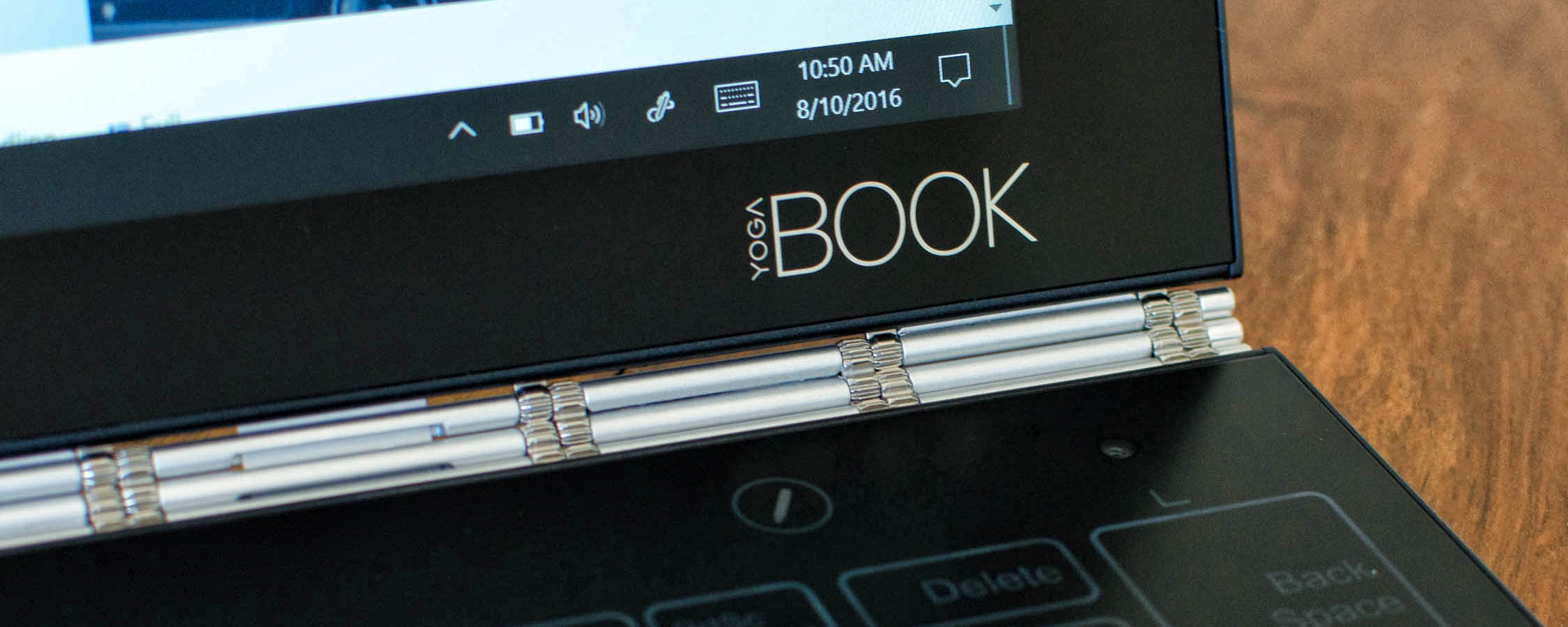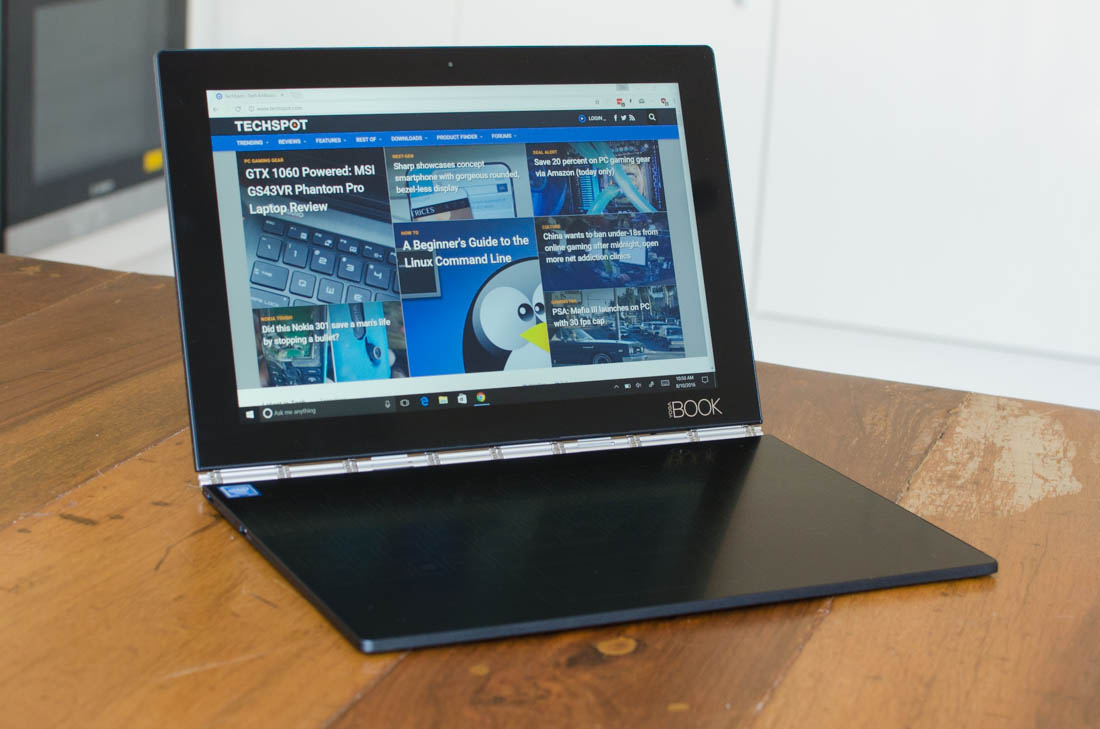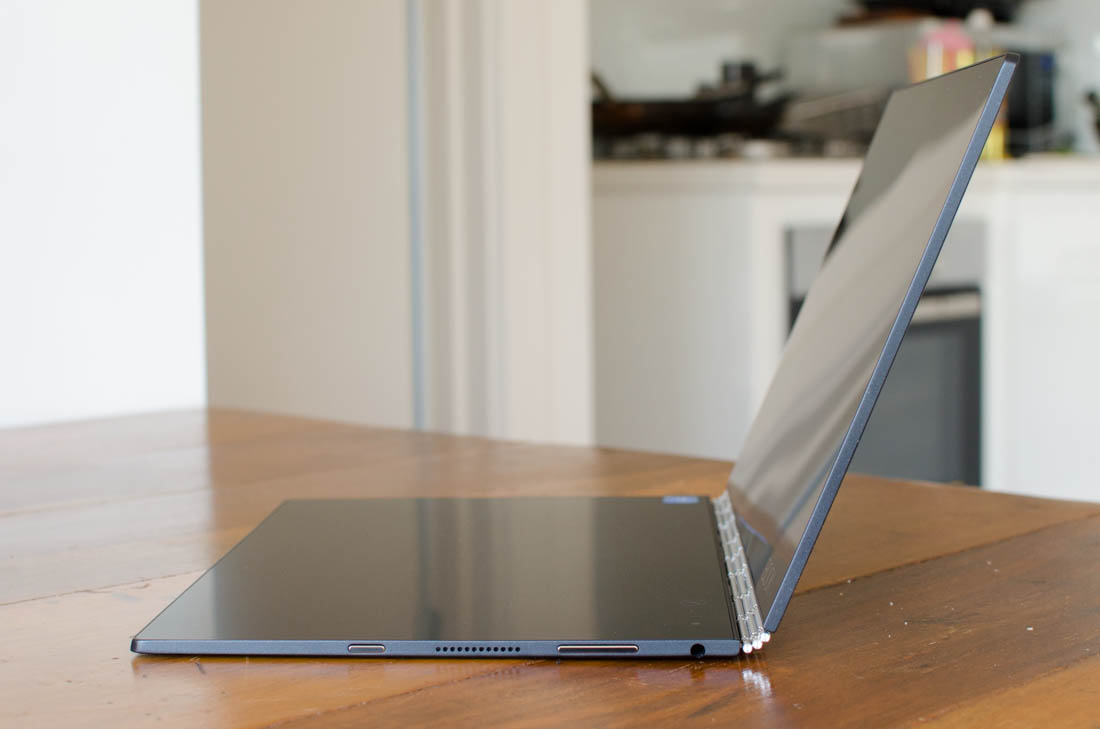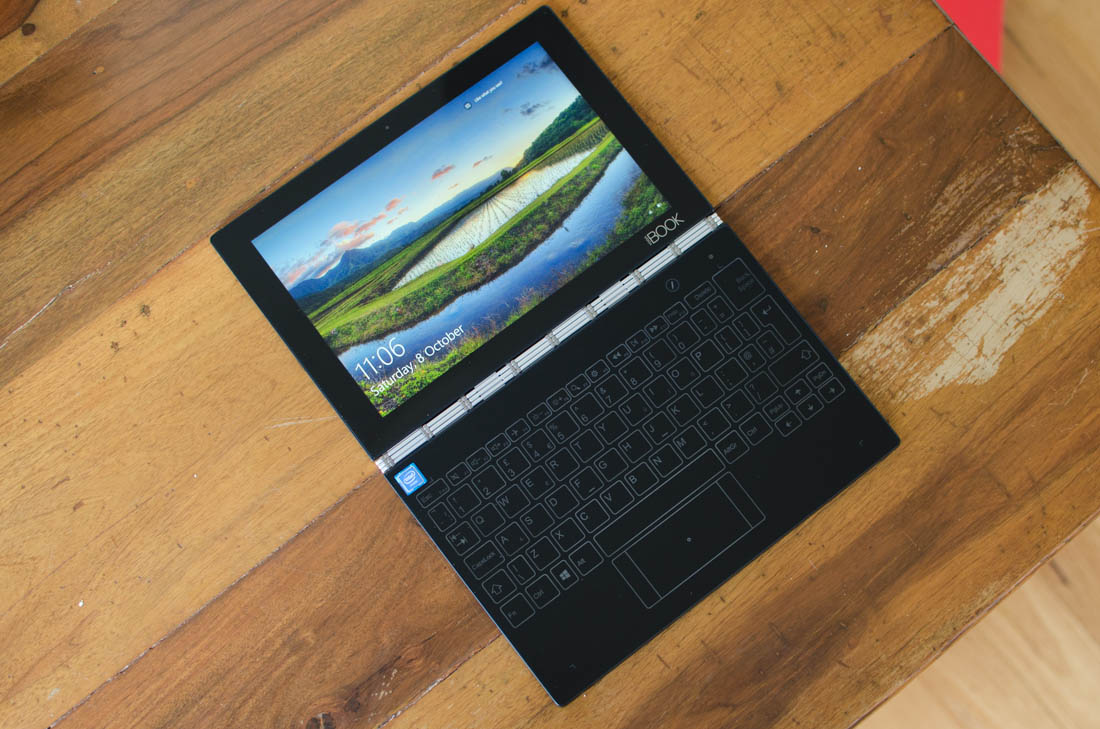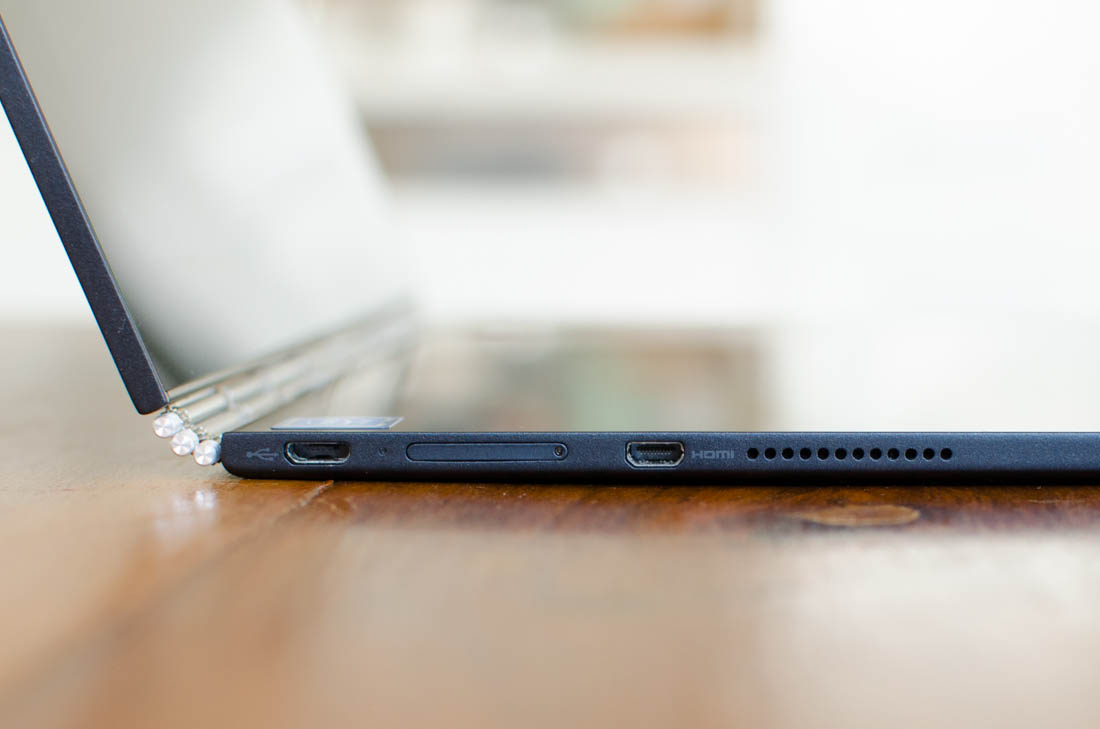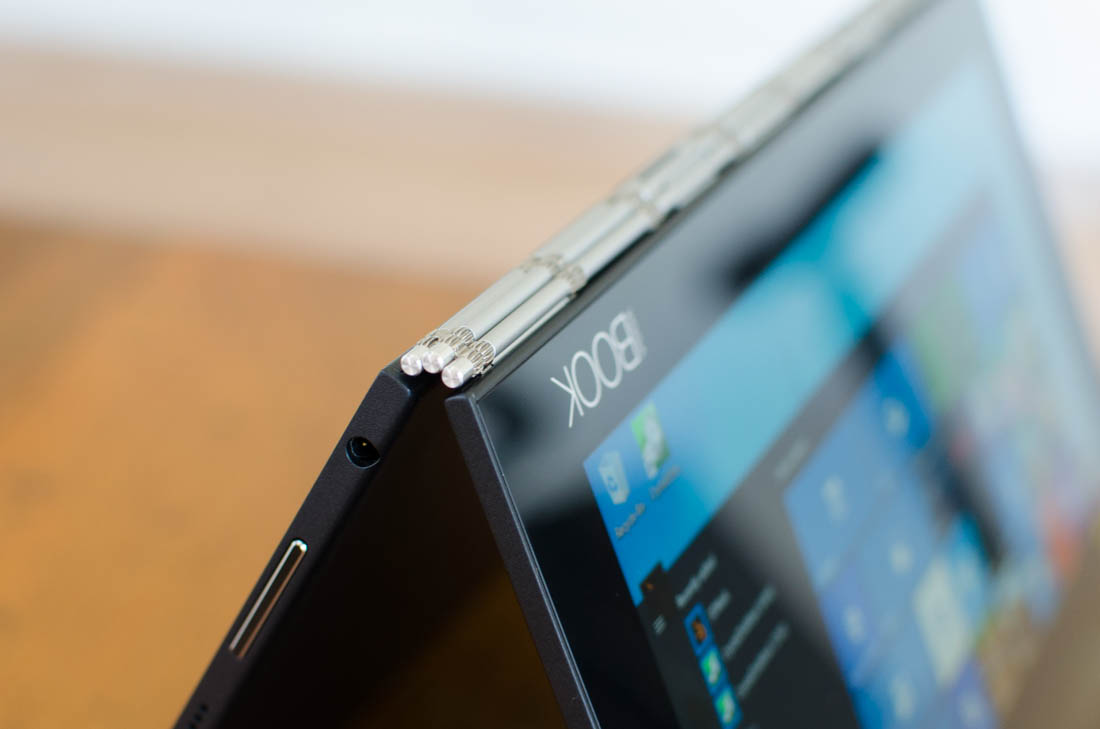The Windows Version of Lenovo's Hybrid Tablet
Ever since Lenovo unveiled the Yoga Book in late August, I've been extremely excited to get my hands on it. This folding tablet-laptop hybrid is unlike any other product on the market, as it takes the concept of the 10-inch tablet with a keyboard and replaces the cumbersome docking mechanism with the Yoga series' signature 360-degree hinge.
The resulting hardware is a beautifully slim tablet that folds apart like a book, transforming it into a lightweight, portable laptop. Lenovo is aiming for the best of both worlds here: a compact tablet that's easy to hold and transport; and an on-the-go laptop that isn't hindered by an awkward dock, mediocre keyboard case, or confusing tablet stand.
To achieve this goal, naturally there are some trade-offs. There is a keyboard attached to this tablet, however there are no physical keys; you're typing on a touchscreen slate.
It's not particularly powerful either, packing an Intel Atom x5-Z8550 processor and 4 GB of RAM.
To make up for these, Lenovo has packed in a range of compelling stylus features. The touchscreen keyboard slate can be used as an accurate graphics tablet with the included pen, or you can slap a piece of paper on the slate and write physical notes while they are simultaneously digitized.
Lenovo also claims the Yoga Book is good for 13 hours of battery life, which sounds impressive considering its size.
The Yoga Book ($550 running Windows, $500 on Android) is one of the most attractive pieces of hardware I've used this year. The magnesium-aluminium alloy shell is sleek and gives this product a premium aesthetic, especially combined with Lenovo's watchband hinge. The frosted glass touchpad complements the design well, as does the glossy glass protecting the display. There are very few distracting elements as well, aside from some removable stickers from Intel and Microsoft, which helps deliver the minimalist look this tablet deserves.
The most impressive aspect to the Yoga Book is how compact the entire device is. It's a 10-inch tablet, so we were always getting a portable footprint, however the slimness is the key to this design's success.
The Yoga Book is just 9.6mm thick when closed, which is unbelievable for a device that opens into two sections. The base, which includes the touch slate, is a slight wedge that maxes out at just over 6mm thick, while the display lid is a slender 3.5mm. When open, the Yoga Book looks astonishing.
Of course a 9.6mm thick 10-inch tablet isn't hugely impressive, so if the Yoga Book were merely a standard tablet I wouldn't be raving about the thickness. The impressive feat here is getting the Yoga Book in its closed tablet mode to match typical 10-inch tablets, while still featuring a hinge that allows it to open into a laptop. There is no product on the market that achieves this, and that's what makes the Yoga Book stand out from such uninteresting competition.
The Yoga Book is one of the most attractive pieces of hardware I've used this year.
In its tablet mode, the 690-gram device is quite usable, but don't expect an experience that rivals the Apple iPad Air 2. Not only is the iPad several hundred grams lighter, but it also features a more comfortable 4:3 screen aspect ratio. The 16:10 display on the Yoga Book makes it a little awkward to use as an entertainment device like the iPad, but it's clear that the strengths of this tablet lie in productivity and creativity instead.
 |
 |
The watchband hinge that connects the two halves of the Yoga Book is as beautiful as it has been on past Lenovo convertibles. The hinge allows 36-degrees of fluid movement, yet it's strong enough that any position you choose will be maintained in a reasonably stable fashion. I say "reasonably" because there is some wobble in the display half when using the touchscreen in laptop mode, however, despite this, the angle of the hinge is maintained.
The touch slate section is interesting as it serves two functions. When typing, the backlit keys appear from nowhere to provide a full keyboard with function keys and a trackpad. But when you hit the pen button, the keyboard disappears and the slate can be used as a graphics tablet within the printed bounds that match the size of the Yoga Book's display. You can still see the outline of the keyboard under light, but the dual-function design is effective.
Around the edges of the touch slate is where you'll find all the key ports and buttons. The right side includes a 3.5mm audio jack, the power button, and the volume rocker, as well as one speaker grill for the stereo side-firing speakers. I did find myself accidentally hitting the power button a few times while I was using the Yoga Book as a laptop due to its awkward position, and I'd rather the power and volume buttons were switched.
On the left side is a rather odd combination of ports: microUSB for charging and accessories, along with micro-HDMI. The Yoga Book is a device crying out for USB-C, so the inclusion of microUSB instead is baffling. And it's not a size issue: there's enough thickness in the Yoga Book to comfortably slot in USB-C, which would have provided greater compatibility with upcoming accessories and removed the need for the HDMI port (USB-C can be easily adapted to full-sized HDMI or DisplayPort).
The inclusion of microUSB over USB-C indicates to me that the Yoga Book has been in development for a long time, and near-final hardware was locked in before USB-C began its surge in late 2015. USB-C is a really disappointing omission from the Yoga Book, but at least with a microUSB to USB adapter you can still attach regular accessories.
The Yoga Book also includes a nano-SIM tray for integrated 4G LTE functionality, and two cameras: one for selfies above the display, in the Book's large bezels; and another above the backspace key in the touchscreen slate. This seems like a weird position for a secondary camera, but when you fold the device into tablet mode, this camera becomes rear facing. Both cameras are pretty average in terms of quality, so I wouldn't want to take any holiday photos on this tablet.
